Intel Alder Lake-H Core i9-12900HK Review: MSI's Raider GE76 Goes Hybrid
by Brett Howse on January 25, 2022 9:00 AM EST- Posted in
- CPUs
- Intel
- MSI
- Laptops
- Alder Lake
- GE76 Raider
- 12th Gen Core
- Alder Lake-H
Gaming Performance
With gaming, there are two camps. With the focus on e-Sports, lower resolution gaming with ultra high framerates is often the key. That is why MSI offers a 360 Hz refresh rate 1920x1080 display in the Raider GE76 that was supplied for testing. If you are after the lowest latency this is a sizable difference over a standard 60 Hz display. The other camp prefers resolution, although ultimately everyone would likely prefer to have both. Unfortunately, current graphics cards for notebooks are still barely able to handle 3840x2160 UHD gaming, although NVIDIA has just released the RTX 3080 Ti for Laptops, which is installed in this test system.
As the focus of this article is on the new Alder Lake processor, the gaming focus needs to be at 1920x1080 where the GPU is the smallest bottleneck, but the Raider GE76 was also connected to a UHD display for additional testing. The CPU will have the biggest impact at 1920x1080, whereas the GPU will be the sole bottleneck at 3840x2160. Let’s start with some synthetics, then move on to gaming tests.
We have recently added some new games to our testing suite, as well as testing at UHD, but since all our review laptops are returned to the manufacturer, there is no way to backfill the data. If a laptop is missing from a result that means it was never tested on that game or resolution.
3DMark
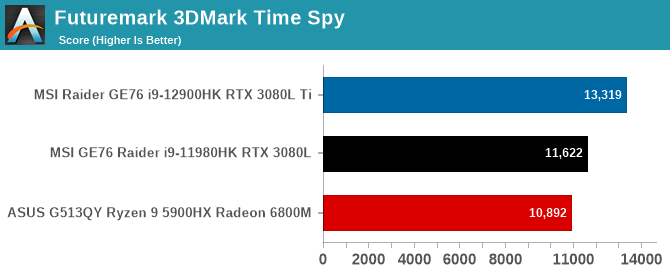
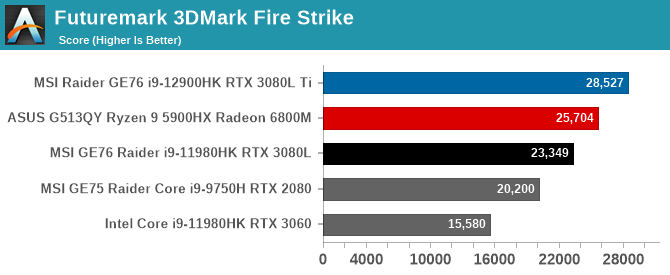
UL’s 3DMark has a variety of graphics tests available to match up with different power devices. We’ve begun the transition to the latest DirectX 12 Time Spy test but will also continue testing the older tests to keep the database current.
The new Raider GE76 is significantly ahead in both Time Spy and Fire Strike, thanks to the new Alder Lake processor and RTX 3080L Ti.
GFXBench
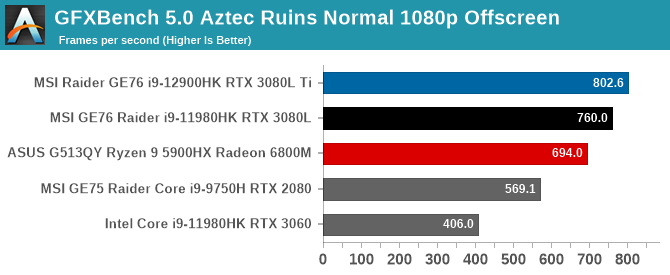
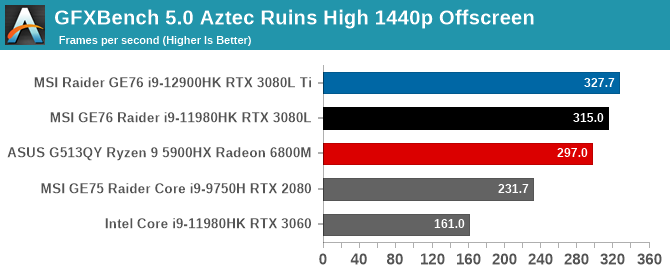
GFXBench offers DirectX 12 versions of Aztec Ruins in both 2560x1440 as well as 1920x1080 resolutions. Although this test is designed for smartphones and low-end PCs, we will include it here since it was run. All of the systems do very well here, although the new Alder Lake system is again in the lead.
Tomb Raider

The original reboot of Tomb Raider can still be a challenge for lower-powered laptops, but not the Raider GE76.
Rise of the Tomb Raider
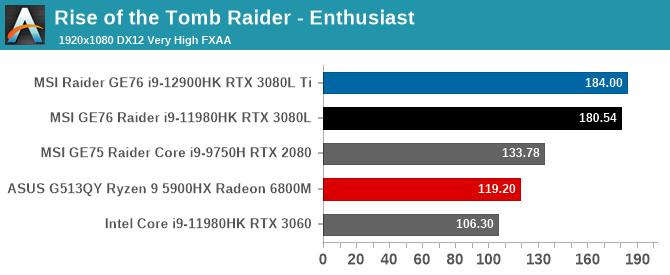
Although much more demanding than the first game in the rebooted franchise, and featuring DirectX 12 support, Rise of the Tomb Raider is not a huge challenge to this system at 1920x1080.
Shadow of the Tomb Raider

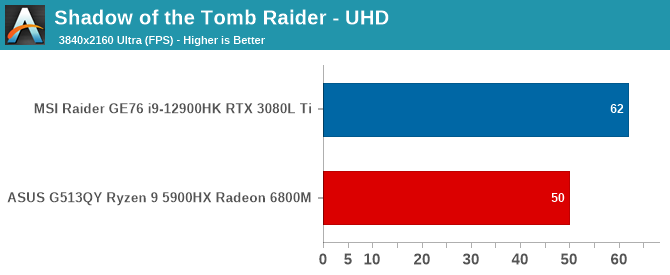
The latest installment is even more demanding, and we capture UHD results as well now for gaming laptops. The Alder Lake system has a sizable lead at 1920x1080 and is able to achieve over 60 FPS average at UHD Ultra.
Strange Brigade


Strange Brigade is not a very demanding game at low settings, allowing it to achieve reasonable framerates on even integrated graphics. The powerful gaming systems can run this at UHD without too much issue.
Shadow of War

At 1920x1080 the Alder Lake system has a commanding lead. As this is an older game that is being phased out, UHD results are not available.
Borderlands 3
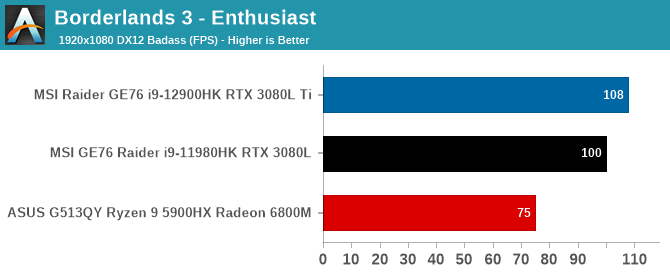

The new Alder Lake system has a slight advantage at 1920x1080 but is almost identical to the previous generation GE76 at UHD.
Assassin’s Creed: Valhalla
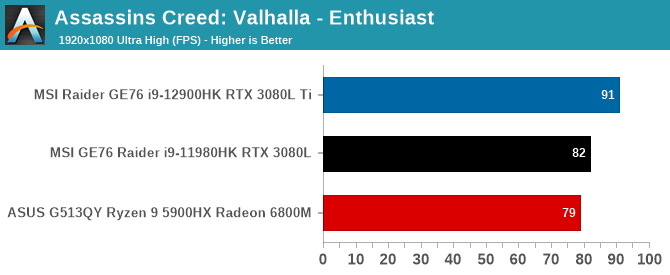

Again, the Alder Lake system has a reasonable lead at 1920x1080, and a smaller lead at 3840x2160.
F1 2021
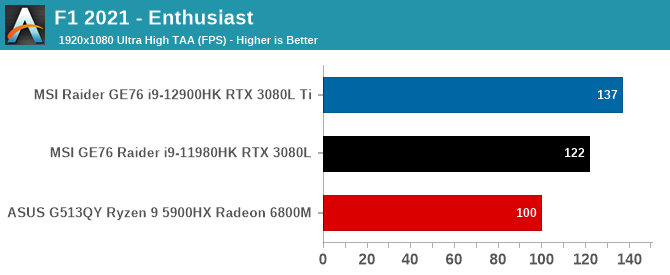

Codemasters F1 series tends to be more CPU bound than some of the other games, so the Alder Lake system can stretch its legs a bit more here at FHD resolutions. At UHD, it is GPU bound.
Far Cry 5

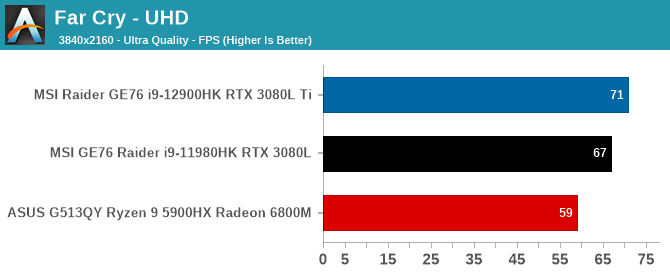
Far Cry is also a title that is more CPU bound than most, and the Alder Lake system can pull ahead here as well.
Godfall
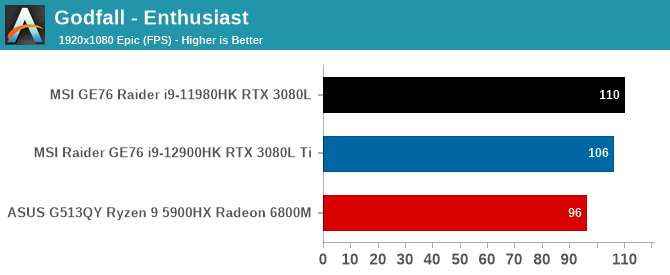
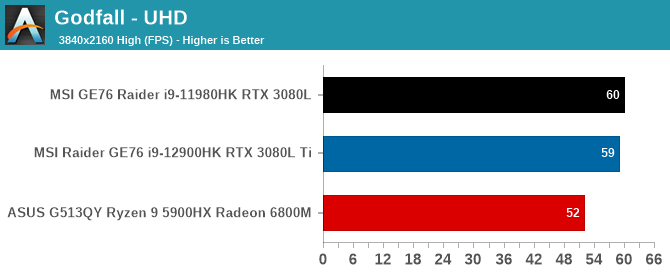
Unlike the other games, the previous generation GE76 Raider with Tiger Lake and RTX 3080L achieves a small win here, but it is likely within the margin of error.
Gaming Performance Summary
With the fastest CPU and the fastest GPU, it should be no surprise that the Raider GE76 system Intel shipped is incredibly potent for gaming. At the lower resolution of 1920x1080 the extra CPU power helps to stretch ahead a bit. At UHD though, where it is GPU bound, unsurprisingly it is not a huge impact on average framerates.


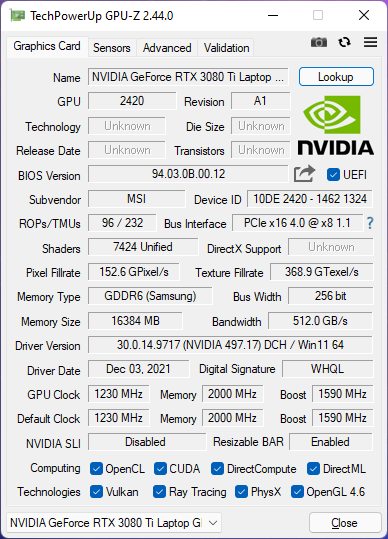








153 Comments
View All Comments
tkSteveFOX - Wednesday, January 26, 2022 - link
Just a note for Brett here, when you do a laptop review thermals, throttling and noise levels are important things to have in the review.Brett Howse - Wednesday, January 26, 2022 - link
This isn't a laptop review. Please check the link to the GE 76 Raider review we did in September.TheinsanegamerN - Friday, January 28, 2022 - link
*reviews laptop CPU**uses laptop*
*this is not a laptop review*
Whew, anandtech quality ladies and gentlemen! I guess that throttling and thermals are not important in CPU tests either? Or would that get in the way of using RAM to exuse the hideous power draw?
corinthos - Wednesday, January 26, 2022 - link
Whole point of a laptop is portability and using unplugged for a considerable amount of the time. That's why you pay a premium. If the best Intel can do is 3.x hours on battery, this is essentially a desktop alternative/replacement, in which case you get even more for your money just buying a desktop.Brett Howse - Wednesday, January 26, 2022 - link
This is literally a desktop replacement. That's actually a product category for notebooks.Spunjji - Thursday, January 27, 2022 - link
I'm sorry you have to keep replying to comments like this...Spunjji - Thursday, January 27, 2022 - link
For me, those "percentage of no load performance" graphs may have been the most interesting. It certainly shows what Alder Lake can offer when it's being used to the fullest. It doesn't represent a use-case that I'd ever put a laptop to, but it will be very interesting for the sort of user for whom 20 threads in a mobile CPU is less a flashy selling point and more a necessity.Otherwise it's looking as I expected - peak performance is significantly better than the ageing Cezanne platform, sustained performance in a slightly more representative platform remains to be seen. Tiger Lake H was ~25% down on Cezanne in terms of performance/watt in multithreaded loads, so there's certainly potential here for Intel to have caught up and maybe even surpassed that.
abufrejoval - Thursday, January 27, 2022 - link
The least impressive statement in this review is this “Perhaps the most impressive result though is Intel’s Thread Director, which provides very impressive system responsiveness even when the system is at 100% CPU load…”, because to me it sounds either like paid content or lack of reflection.Intel is pushing E-cores as a “must have”, because it’s exclusive to their platform, very much like MMX or AVX-512 back then.
But it’s mostly yet another marketing smoke bomb.
I am convinced you could achieve a very similar gain in responsiveness by emulating the 8 E-cores via the 2 P-cores they replace in terms of silicon real-estate on Alder Lake. What you perceive as a hardware benefit is mostly an OS defect in workload management.
What happens here is that long running batch and latency sensitive interactive workloads are being separated and assigned to hardware partitioned processing pools dependent on whether they are running in the “foreground” or “background”. Doing that in the Windows task manager today, is obviously cumbersome, but writing a tool that prohibits the usage of all CPU cores once workloads are switched to background, should be trivial enough. And to my knowledge even cache partitioning has been part of x86 since Broadwell to ensure that busy background batch tasks won’t flush latency sensitive interactive workloads entirely from them.
Yes, E-cores have been proven to squeeze longer run times out of smartphones or more concurrent session support per Watt in certain cloud servers, because they are designed to be more efficient in in terms of instructions per Watt/h at the price of instructions per unit of time.
But those constraints do not apply to a gaming laptop or most desktop computers. Actually, even on ultra-thin laptops CPU core power consumption is becoming a rather insignificant contributor to overall energy spend, outside of some synthetic fringe cases.
Intel fits 8 E-cores into a similar space for 2 P-cores, so the high-end mobile Alder-Lake parts could just be 8 P cores or 32 E cores or any of the other permutations. And quite obviously you would be able to find workloads with an ideal fit for each, just as you’d also find workloads that violate either performance or efficiency targets on them.
Intel promotes a hardware partitioned compromise between E- and P-cores and then interestingly charges an E-core premium on desktop parts, where collective energy savings on remotely managed always-on volume parts might actually provide an ecological benefit. But I can’t help thinking, that a software solution via “E-core emulation” would deliver more flexibility and adjustable performance on most laptops and workstations and prefer 8P+0E over 6P+4E practically everywhere except server parts.
Bik - Thursday, January 27, 2022 - link
Simple thought will prove this correct: a big task that feels like it bogs down the whole system, will no longer be so if you willing to sacrify some cores for background tasks. The scheduler just isnt smart enough to do that today.There's another thing I notice. When it is true that 8-E cores put up more performance than 2-P cores, Intel claims of silicon real-estate between the two being equal may not be correct. Because if they do, we'll surely have all E-cores cpu for heavy multi-thread work loads. But that didnt, and I doubt, will ever happen.
diediealldie - Thursday, January 27, 2022 - link
oh, they will. There's Sierra Forest AP which consists of 128 e-cores. Intel is not making all e-cores yet since launched platforms are kind of mass-market general-purpose ones which need high ST performance along with good MT performance.